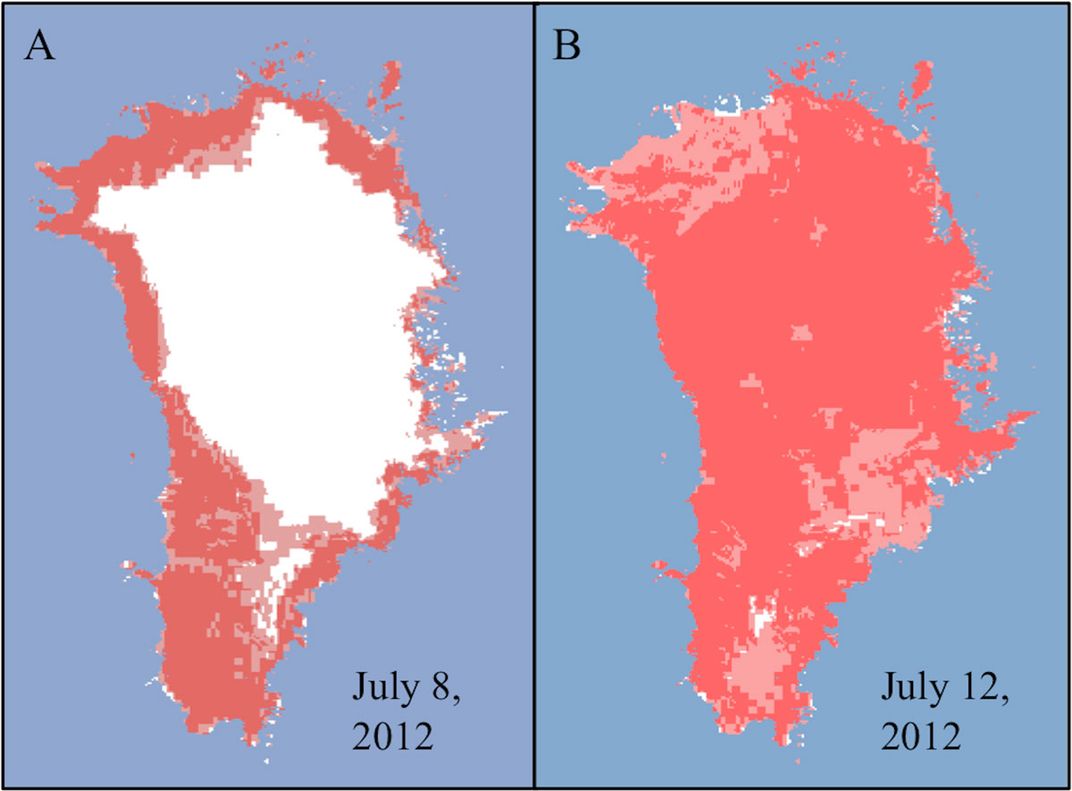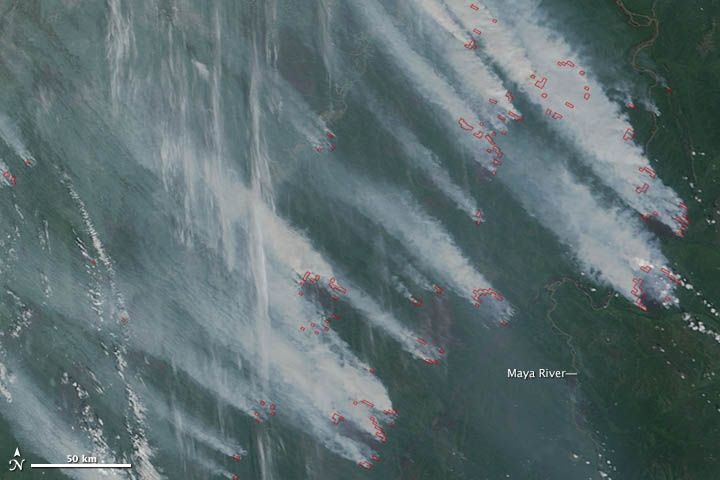Nearly All of Greenland’s Surface Melted Overnight in 2012—Here’s Why
High temperatures and black carbon from forest fires and fossil fuels combined to push the huge ice sheet over the edge
/https://tf-cmsv2-smithsonianmag-media.s3.amazonaws.com/filer/c7/62/c76243e9-d13a-4a26-80ac-a1d10dc9340f/greenland_ice.jpg)
On July 12, 2012, the Indian Space Research Organization satellite Oceansat-2 detected something odd in Greenland: In just a couple of days, the surface of the interior of the glacier-covered island melted. Although ice still persisted under the melt, about 97 percent of all of Greenland was covered with meltwater.
This was the first time such an occurrence had been detected in the satellite era. And scientists could see from matching refrozen slicks in several ice cores that the last time such an event happened was back in 1889.
At the time of the melt, scientists weren’t sure what was going on. There was unusually warm air sitting over Greenland at the time. And that was a known contributor to the event. But it was black carbon from forest fires in North America and Siberia, as well as from the burning of fossil fuels, that tipped the ice over the edge, Kaitlin M. Keegan of Dartmouth College and colleagues report today in the Proceedings of the National Academy of Sciences.
The ice sheets sitting atop Greenland and Antarctica hold nearly all of the planet’s freshwater. And if they melted, Greenland would contribute about 6 meters (20 feet) to sea level and Antarctica around 60 meters (200 feet). Neither is expected to melt wholesale anytime soon, but scientists have found that their ice is indeed starting to turn to water.
The news in Antarctica has been especially troubling: Today comes news that the continent is losing ice faster than ever. Much of that loss is happening in West Antarctica. That comes on top of findings announced last week that the melting of the ice sheet in West Antarctica is now unstoppable. At least several feet of sea level rise are thus inevitable and (if no preventative measures are taken) will drown many coastal cities, such as Miami, New Orleans and Tokyo, as well as low-lying island nations. This won’t happen overnight, however, as the ice sheet collapse is expected to take 200 to 1,000 years.
Though the ice sheets in Greenland and Antarctica are often mentioned together, the dynamics of their melting differ greatly. Antarctica is incredibly cold, and melting there occurs because of warm water eating away at the edges of the continent.
Greenland, however, isn’t as cold. Greenland sits farther from its pole, and its region of the world has been warming faster than average. Temperatures there are closer to water’s melting point, so it doesn’t take too much warming to push glaciers over the edge.

The years 1889 and 2012 were warm for Greenland, but they weren’t the warmest. Temperatures were warmer in 1785, for instance, but there’s no indication of widespread melting that year in the ice core data. Warm air, though, isn’t the only feature that can lead to glacier ice melting at the surface. The reflectance (or as scientists put it, the albedo) of the snow is another important factor.
Albedo is a measure of how much energy gets reflected from a surface. Generally, the whiter a surface is, the more energy it reflects. This is why you stay cooler under the sun if you’re wearing a white shirt versus a black shirt. The black color absorbs more of the sun’s heat.
Though snow and ice generally reflect most of the light that hits them, this whiteness can decline due to black carbon. Black carbon, a major component of soot, forms when combustion is incomplete. Sources include the burning of fossil fuels—especially in vehicles—and the burning of biomass, whether on purpose (say, in cooking fires) or not (such as in wildfires). These sooty components land on snow and start absorbing rather than reflecting heat, causing the ice underneath to melt.
The average amount of black carbon in the air has generally reflected the path of human industrialization: From 1851 to 1950, black carbon concentrations were about twice what they were in the pre-industrial period. But they dropped after that time, as many developed nations implemented pollution controls. These trends are reflected in the Greenland ice cores.
But those ice cores also show several spikes in black carbon—in 1868, 1889, 1908 and 2012. That led the researchers to realize that it was the combination of higher temperatures and the influence of these spikes in black carbon that led to the melting events in 1889 and 2012. In other words, each factor separately wasn’t enough to cause the melting.

Ammonium signatures in the black carbon suggest that much of it came from forest fires. The Pacific Northwest experienced bad wildfires in the summer of 1889. The summer of 2012 saw numerous forest fires in North America and Siberia. Such events deposit black carbon high into the atmosphere, where it moves around the world.
Melt events like the one seen in 2012 don’t contribute to sea level rise because the water trickles into the ice below and refreezes. But such events probably lower the ice sheet’s albedo and leaves is susceptible to more melting in the future. And these events are likely to become more common, write Keegan and her colleagues.
Climate change is causing increases in both air temperatures and the frequency of wildfires. That combination could increase the probability of surface melt events in Greenland to once a year by 2100. And that, the researchers write, would contribute to the “further demise of the Greenland Ice Sheet.”
/https://tf-cmsv2-smithsonianmag-media.s3.amazonaws.com/accounts/headshot/Sarah-Zielinski-240.jpg)
/https://tf-cmsv2-smithsonianmag-media.s3.amazonaws.com/accounts/headshot/Sarah-Zielinski-240.jpg)